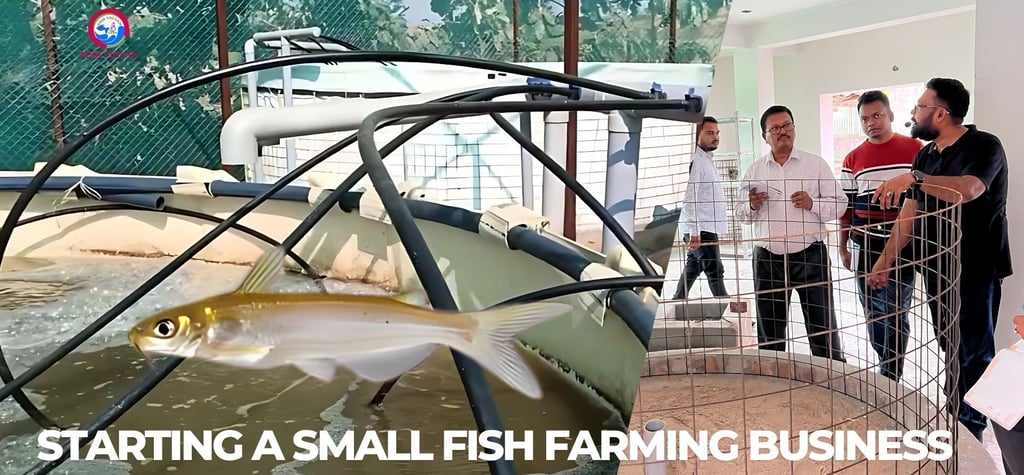How to Start a Small Fish Farming Business
Fish farming is a profitable and sustainable business that ensures a steady income while supporting food security. This guide covers essential steps to start a small fish farm, highlighting biofloc fish farming as a cost-effective and eco-friendly method.


1. Understanding Fish Farming
Fish farming, also known as aquaculture, is the process of raising fish for commercial purposes in controlled environments such as ponds, tanks, or cages. It is a lucrative venture that requires proper planning, investment, and knowledge of fish care.
2. Why Choose Biofloc Fish Farming?
Low Water Requirement: Biofloc technology reduces water exchange.
Cost-Effective Feed Management: Microbial biofloc acts as a natural feed source.
High Stocking Density: More fish can be farmed in smaller areas.
Eco-Friendly: Recycles fish waste into protein-rich feed.
Better Disease Control: Reduces the risk of infections and mortality.
3. Choosing the Right Fish Species
For biofloc fish farming, selecting species that thrive in high-density environments is crucial. Suitable species include:
a) Tilapia
Fast-growing and highly adaptable.
High market demand.
b) Catfish
Hardy and disease-resistant.
Well-suited for biofloc systems.
c) Common Carp
Tolerates varied water conditions.
Popular in Indian markets.
d) Prawns and Shrimps
Ideal for biofloc culture due to their feeding behavior.
High market value.
4. Setting Up a Biofloc Fish Farm
Biofloc fish farming can be implemented in tanks, ponds, or indoor setups. Follow these steps:
Install Biofloc Tanks: Use circular tanks (5,000-10,000 liters capacity).
Aeration System: Set up blowers and diffusers for oxygen supply.
Prepare Biofloc Culture: Add carbon sources (molasses, jaggery) to develop beneficial bacteria.
Maintain Water Quality: Monitor pH, ammonia, and dissolved oxygen levels.
Stocking Fingerlings: Introduce healthy, disease-free fingerlings.
5. Feeding and Nutrition in Biofloc
Use high-protein feed (floating pellets).
Monitor fish growth and adjust feed accordingly.
Avoid overfeeding to maintain water quality.
6. Maintaining Biofloc Water Quality
pH Balance: Maintain between 6.5 - 7.5.
Ammonia Levels: Keep below 0.25 ppm.
Aeration: Ensure 24/7 oxygen supply.
Turbidity Management: Monitor biofloc concentration and dilute if necessary.
7. Preventing Diseases and Predators
Regularly inspect fish for signs of illness.
Control stocking density to avoid stress.
Install protective nets to prevent bird attacks.
8. Harvesting and Selling Fish
Harvest fish at 300-500 grams per piece (optimal market size).
Sell fresh or process into dried/smoked products.
Target local fish markets, hotels, and direct consumers.
9. Cost and Investment Breakdown (Indian Market Perspective)
The cost of starting a biofloc fish farming business in India depends on various factors, including land, equipment, and operational expenses. Estimated costs are as follows:
Land/Water Source: ₹50,000 - ₹2,00,000
Biofloc Tank Setup: ₹25,000 - ₹1,00,000
Fingerlings: ₹10,000 - ₹50,000
Fish Feed: ₹20,000 - ₹1,00,000
Aeration System: ₹30,000 - ₹1,50,000
Miscellaneous Expenses: ₹20,000 - ₹50,000
Total initial investment for a small-scale biofloc fish farm ranges between ₹1,50,000 and ₹6,50,000.
10. Challenges in Fish Farming
Initial Investment Costs: Equipment and setup require capital.
Technical Knowledge: Understanding biofloc system management is essential.
Water Quality Management: Constant monitoring is required.
Market Fluctuations: Prices vary based on demand and season.
11. Tips for Success in Biofloc Farming
Start Small: Gain experience before expanding.
Continuous Learning: Stay updated on biofloc best practices.
Seek Expert Advice: Join biofloc training programs.
Direct Marketing: Sell directly to consumers to maximize profits.
Diversification: Expand into prawn/shrimp farming for higher returns.
12. Conclusion
Biofloc fish farming is an innovative and profitable method for small-scale fish farming. With lower water requirements, cost-effective feeding, and high stocking density, it is an excellent choice for aspiring fish farmers. By carefully managing water quality, feeding, and harvesting, you can create a successful fish farming business in India.
If you are ready to begin, start with market research, arrange initial investment, and take step-by-step actions towards success. Happy fish farming!
